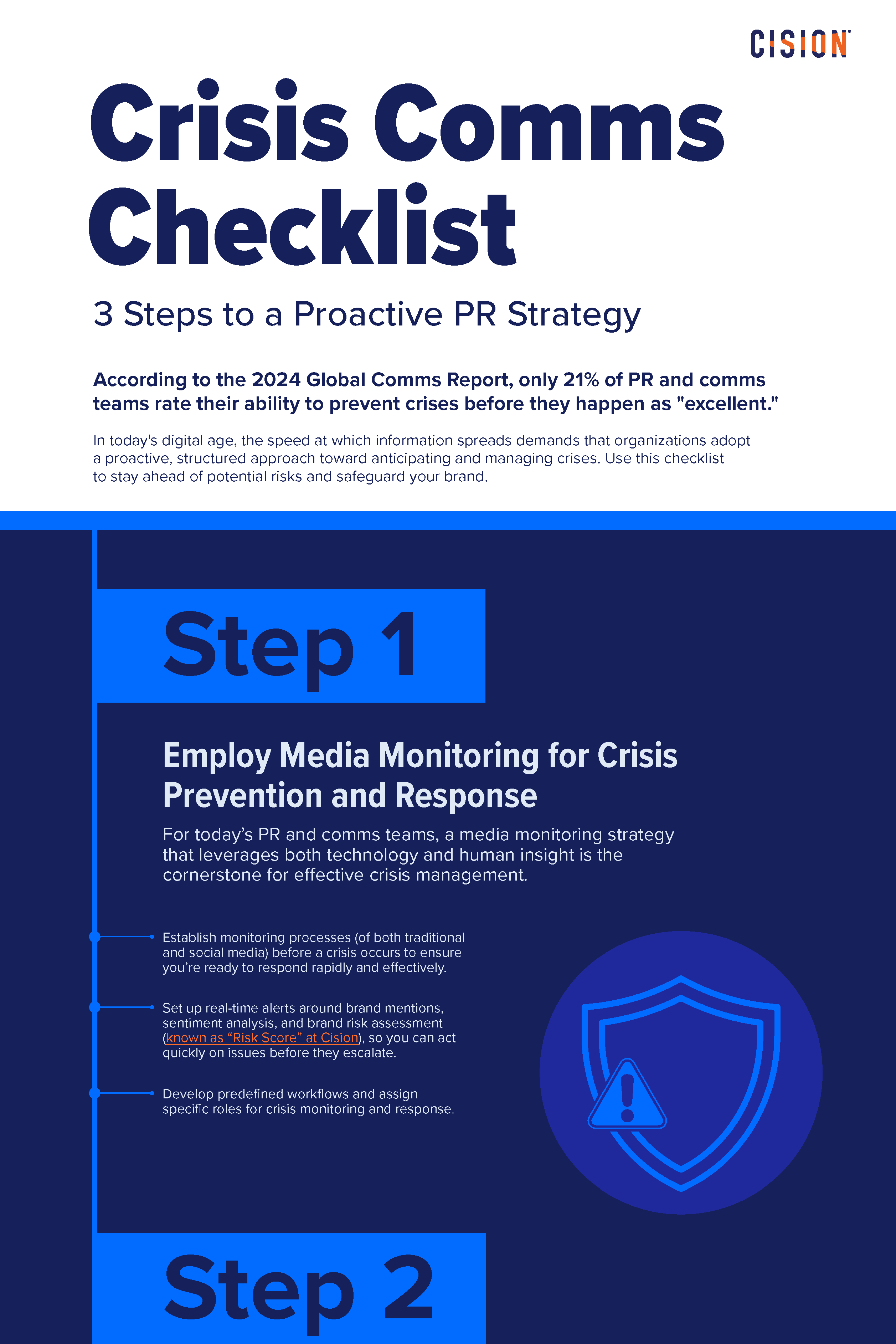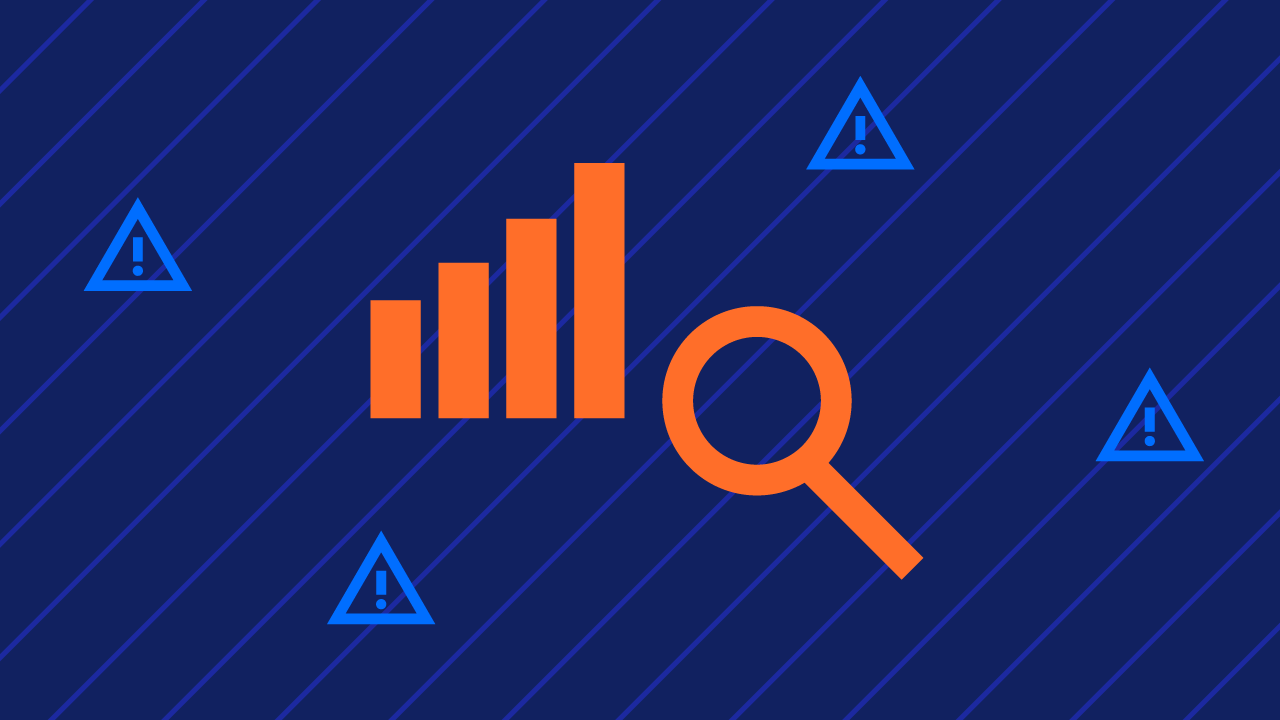For public relations professionals, managing brand reputation is a constant challenge. With social media enabling users to share and comment instantly from across the globe and the 24/7 news cycle constantly pumping out updates, there’s an endless stream of conversations taking place at any given moment.
Understanding what’s being said and the meaning behind it is a must in PR, and it’s even more critical when your brand is on the cusp of a comms crisis or smack dab in the middle of one. Yet only 31% of comms leaders feel confident in identifying an emerging crisis, or managing one if it occurs, according to the Global Comms Report.
So, what’s the solution? Media monitoring empowers PR and comms professionals to take control of unfavorable narratives and change the conversation to minimize (or prevent) the damage to an organization’s reputation and financials.
That’s what we’re digging into here: Why media monitoring is so important, its pivotal role in crisis prevention and management, and steps you can take now to prepare for a crisis.
Why Is Media Monitoring Important in PR?
Media monitoring is the act of tracking and analyzing media content – such as news articles or broadcasts and social media – to better understand how a brand is being talked about and perceived. In short, it provides critical information for the PR teams charged with managing a brand’s reputation.
Most PR teams rely on media monitoring tools to track and analyze mentions of a brand, competitors, industry, and relevant topics across all media channels. And the best monitoring tools include access to content published online, in print, on social media, via broadcast and podcasts, and even premium content that sits behind paywalls.
As you can imagine, the volume of information available to track is vast and can often be overwhelming. Media monitoring is the best way to stay on top of the latest conversations and sentiment surrounding a brand in real-time. The benefits of media monitoring include:
- Understand Your Audience: With better intel on your audience, organizations can improve products and services, provide better customer service, and address negative feedback immediately. Additionally, knowing the topics and messaging that resonates best with target audiences is powerful insight for PR and comms strategies.
- Identify Industry Trends and Opportunities: By tracking relevant keywords and phrases, you can identify emerging trends, hot topics, and influential voices within your audience. You can capitalize on these buzzworthy trends and look for partnership opportunities with other brands or influencers.
- Analyze Your Competitors: Media monitoring lets you track competitors' media coverage, campaigns, and messaging strategies. See what’s gaining traction and what’s resonating with audiences to help inform your own strategy.
- Find the Right Media Partners: Identify journalists and influencers who are covering topics related to your industry or brand - use this info to not only build relationships with relevant contacts, but also to inform your pitching.
- Measure Your Impact: Most media monitoring tools give you PR metrics that help gauge the effectiveness of campaigns and media outreach efforts. This data can help refine your strategies, justify your efforts, and show the value of your work to leadership or clients.
- Prevent or Manage Crises: Monitoring offers early identification of negative trends or conversations, giving you the ability to intervene and prevent a full-scale crisis. And in the event of a crisis, media monitoring tools track the spread of information and public sentiment in real-time.
Media Monitoring: Critical for PR Crisis Prevention & Management
Media monitoring plays a key role in not only managing a PR crisis when one occurs, but also in preventing crises before they spiral out of control. It gives comms teams early signals of potential issues, so they can take proactive measures to mitigate damage.
PR Crisis Prevention
When it comes to a potential brand issue, PR and comms should be the first to know about it.
Media monitoring offers an early warning system, alerting to potential issues or negative sentiment brewing online or in traditional media before it has a chance to escalate.
By tracking coverage and online conversations, you can also identify areas that need to be addressed, such as:
- Potential reputational risks
- Public misconceptions
- Spikes in negative sentiment
- Areas of concern for customers
- Misinformation about your brand
Some media monitoring tools have features built in and specifically designed to help brands identify content that can lead to crises. For example, CisionOne’s AI-powered React Score metric identifies potentially harmful content in real-time, so you can monitor and intervene as appropriate.
Managing a PR Crisis
If and when a crisis does strike, media monitoring becomes mission-critical, helping you:
- Track real-time coverage across all channels as the crisis unfolds
- Pinpoint the hotspots and most influential voices driving the conversation
- Analyze sentiment to understand the public's reaction
- Disseminate crisis response communications (e.g., press releases, statements, social media updates) and measure reach and impact
Real-time intelligence is essential for PR and comms teams to develop messaging that addresses the specific concerns and audiences involved. With constant visibility into the situation as it evolves, you can rapidly adapt your strategies as needed.

Monitor the Effectiveness of Your Crisis Response
Of course, you also need to know if your efforts to resolve the crisis are having the desired effect.
Sentiment analysis within your media monitoring tool can help you gauge the public's perception toward your crisis response. Metrics on the reach and engagement of your crisis communication materials and outreach efforts also help validate your response’s effectiveness.
As you continue to monitor the situation, you can identify any gaps in the crisis response strategy, areas of concern that need to be addressed, or opportunities to adjust messaging or tactics.
Once the crisis dissipates, media monitoring can help track the gradual recovery of the organization's reputation by tracking changes in sentiment, brand perception, and media coverage over time.
Preparing for a PR Crisis
It may go without saying, but the most critical steps to managing a crisis happen long before it hits. Establish your crisis communication processes ahead of time, so you’re better equipped to handle whatever gets thrown your way.
Our Crisis Comms Checklist provides details on how you can proactively prepare for a crisis by leveraging media monitoring, ensuring effective stakeholder communication, and identifying the voices who can best influence the conversation during a crisis.

Executive Communications Crisis Comms
Along with the guidance in the Crisis Comms Checklist, you’ll want to have a robust executive communication strategy in place, before it’s needed.
With the increasing influence of PR and comms, all eyes will be on you should a crisis emerge. Be prepared to share meaningful updates and counsel with the C-suite and key decision-makers.
Here are some important considerations for your executive communications crisis processes:
- Media Monitoring Point Person: Who runs point on monitoring the media on a day-to-day basis? Should this responsibility shift to someone else in a crisis?
- Frequency of Updates: Should you produce an update daily on coverage and online conversations, or will you need more frequent updates? Are regular check-in meetings needed? No matter what your circumstances, it’s important to be clear about when you’ll share updates and avoid sending one-offs as news comes in.
- Distribution Channels: How widely will your updates be distributed? Who should be on the distribution list? Who is on point for disseminating appropriate updates to the broader employee group, shareholders, customers, etc.?
- Content Curation: Who is responsible for the content provided in leadership updates? Do they have the knowledge and resources to distill the information? It’s up to your team to sift through the noise to put the right information in front of your leaders.
- Communication Format: Will the leadership team expect a printed copy of ongoing updates, an email with an attachment, or something more mobile-friendly? Do they want the full story or a few key bullet points? You’ll want to understand their preferences beforehand and gain their buy-in on the standard procedure you’ll follow.
Don’t wait until it’s too late. Find out how CisionOne Monitoring can help you prepare before a crisis hits. Take time to speak with one of our experts.








